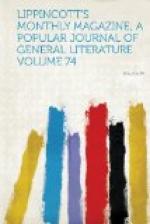soul to the perfection of the body. Every man
was great in its eyes, not by his perishable members,
but by his immortal soul. With this religion
begins the reign of painting, which is a more subtle
art, more immaterial, than the others—more
expressive, and also more individual. We will
give some proofs of it. Instead of acting, like
architecture and sculpture, upon the three dimensions
of heavy matter, painting acts only upon one surface,
and produces its effects with an imponderable thing,
which is color—that is to say, light.
Hegel has said with admirable wisdom: ’In
sculpture and architecture forms are rendered visible
by exterior light. In painting, on the contrary,
matter, obscure in itself, has within itself its internal
element, its ideal—light: it draws
from itself both clearness and obscurity. Now,
unity, the combination of light and dark, is color.’
The painter, then, proposes to himself to represent,
not bodies with their real thickness, but simply their
appearance, their image; but by this means it is the
mind which he addresses. Visible but impalpable,
and in some sense immaterial, his work does not meet
the touch, which is the sight of the body: it
only meets the eye, which is the touch of the soul.
Painting is then, from this point of view, the essential
art of Christianity.... If the painter, like
Phidias or Lysippus, had only to portray the types
of humanity, the majesty of Jupiter, the strength
of Hercules, he might do without the riches of color,
and paint in one tone, modified only by light and
shade; but the most heroic man among Christians is
not a demigod: he is a being profoundly individual,
tormented, combating, suffering, and who throughout
his real life shares with environing Nature, and receives
from every side the reflection of her colors.
Sculpture, generalizing, raises itself to the dignity
of allegory—painting, individualizing,
descends to the familiarity of portraiture.”
Let us now return to consider William Hunt’s pictures from this second point of view. The gift of Verity having been already assumed, can we also discern that higher power of Imagination whose crown and seal is the Beautiful. To decide this question we have, unhappily, to consider his work as lyrical, rather than dramatic, and for this reason we must study his power under disadvantage. That he possesses dramatic power will hardly be denied by those who know his “Hamlet,” “The Drummer-Boy,” and “The Boy and the Butterfly;” but the exigencies of life appear to prevent him from occupying himself with compositions such as filled years in the existence of the old painters.




